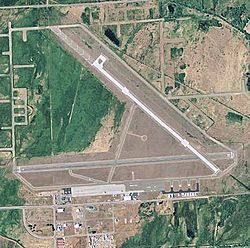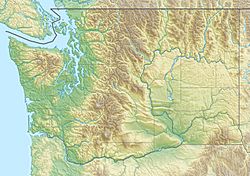Bowers Airport facts for kids
Quick facts for kids
Bowers Field
(former Ellensburg Army Airfield)
|
|||||||||||
|---|---|---|---|---|---|---|---|---|---|---|---|

USGS 2006 orthophoto
|
|||||||||||
| Summary | |||||||||||
| Airport type | Public | ||||||||||
| Owner | Kittitas County | ||||||||||
| Serves | Ellensburg, Washington | ||||||||||
| Elevation AMSL | 1,764 ft / 538 m | ||||||||||
| Coordinates | 47°01′59″N 120°31′50″W / 47.03306°N 120.53056°W | ||||||||||
| Map | |||||||||||
| Runway | |||||||||||
|
|||||||||||
| Statistics (2012) | |||||||||||
|
|||||||||||
|
Source: Federal Aviation Administration
|
|||||||||||
Bowers Field (IATA: ELN, ICAO: KELN, FAA LID: ELN) is a public airport in Kittitas County, Washington, United States. It is owned by Kittitas County. The airport is located about 2 nautical miles (4 km) north of downtown Ellensburg, Washington.
Bowers Field is part of the National Plan of Integrated Airport Systems. This plan helps decide which airports are important for the country. It is mainly a general aviation airport. This means it is used by smaller planes, not big passenger planes. It is also used for flight training.
Contents
History of Bowers Field
Early Days as an Army Airfield
The airport first opened in 1943. It was called Ellensburg Army Airfield back then. It was run by the 302nd Base Headquarters and Air Base Squadron.
The airfield was meant to be a base for fighter planes. But it became a place for fixing and supplying aircraft instead. It helped planes that were being sent to Alaska. From there, they would go to the Soviet Union to help during World War II. This program was called Lend-Lease, where the U.S. helped other countries with supplies.
There was also a smaller, extra airfield nearby. It is now abandoned. You can still see parts of its old runway in aerial photos.
Becoming a Public Airport
The military stopped using the airfield in February 1945. After the war, it was given to Kittitas County. The county then turned it into a public airport for everyone to use.
The airport was renamed Bowers Field to honor Ensign Keith Bowers. He was the first person from Kittitas County who died in World War II. Ensign Bowers was at Pearl Harbor when it was attacked by Japan on December 7, 1941. During the war, the field was also used to train military pilots.
Central Washington University's Aviation Program
Since 1975, Central Washington University has had an aviation program at Bowers Field. It is the only fully approved public university aviation program in the Pacific Northwest region.
Most of the takeoffs and landings at Bowers Field are for this program. Central Washington University now uses hangar space and other airport services. They have also started hiring their own flight instructors. The university also leases and buys its own planes for training. The Federal Aviation Administration (FAA) has given the school its pilot training certification.
Today, you can still see many old areas where planes were kept during the war. There are also many taxiways, which are paths planes use to move around the airport. Some modern plane shelters are also there.
Airport Features and Planes
Bowers Field covers a large area of 1,032 acres (418 ha). It is about 1,764 feet (538 meters) above sea level.
Runways
The airport has one main runway. It is called 11/29. This runway is 4,301 feet (1,311 meters) long and 150 feet (46 meters) wide. It has a concrete surface. There used to be another runway, but it was closed in 2018.
Airport Activity
In the year leading up to May 30, 2012, there were 60,445 aircraft operations at the airport. An "aircraft operation" is one takeoff or one landing. This means there were about 165 operations every day.
Most of these operations (97%) were for general aviation. About 3% were "air taxi" flights, which are like small, private charter flights. A very small number were military flights.
Planes Based Here
At that time, 48 aircraft were based at Bowers Field. "Based aircraft" means planes that regularly stay at the airport. Most of these planes (90%) had only one engine. About 8% had multiple engines. The remaining 2% were gliders, which are planes that fly without an engine.


